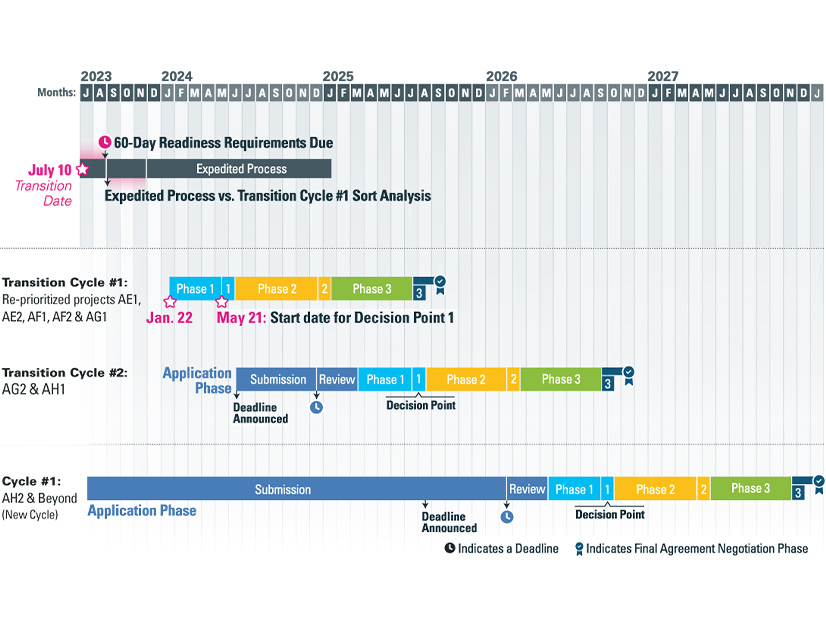
PJM on May 20 announced that it had completed the first phase of studies for 306 generation interconnection requests sorted into the first cycle in the transition to its new interconnection process, a cluster-based study approach intended to reduce how long it takes the RTO to bring generators online.
“This is another critical milestone for PJM’s widely supported interconnection process reform,” said Aftab Khan, executive vice president of operations, planning and security. “New service requests for generation resources are moving through our process as designed and promised, with more than 200,000 MW of projects to be studied over the next two years to help states advance their energy policy goals.”
Developers with projects in Transition Cycle 1 (TC1) will have 30 days to review the system impact studies and decide whether to move forward with their projects to the facility study phase. PJM said those that complete the process will be ready for construction by mid-2025. (See PJM Initiates Transitional Interconnection Queue.)
Another 306 projects expected to require minimal network upgrades are being studied through an Expedited Process “fast lane” that is expected to yield final interconnection service agreements (ISAs) throughout this year. PJM also plans to initiate Transition Cycle 2 on June 20, with a likely application deadline by Dec. 16.
PJM said about 72 GW are expected to clear the queue by mid-2025 and 230 GW over the next three years, more than 90% of which is renewable energy or storage.
The cluster-based approach groups projects together on a first-ready, first-served approach to identify any grid upgrades and assign costs. It also includes increasingly large readiness deposits to be made throughout the study process, with the aim of discouraging speculative or uncertain projects from taking focus away from others. PJM said 118 projects have dropped out of the queue or failed to post deposits, out of 734 eligible. (See FERC Approves PJM Plan to Speed Interconnection Queue.)
Environmental organizations said the milestone is a welcome first step but that more change is needed.
“PJM worries there’s not enough new power coming online, but it’s still only approving projects proposed four to six years ago,” said Tom Rutigliano, of the Natural Resources Defense Council. “This is a step forward, but PJM’s current process is not enough to get these new clean energy projects connected to the grid as quickly as they’re needed.”
Christine Powell, deputy managing attorney at Earthjustice, said the amount of time it has taken for PJM to get to this stage has already resulted in projects stalling or withdrawing from the queue. “While PJM’s shift to a cluster study process is a positive development for the hundreds of clean energy projects waiting to interconnect to the power grid, PJM continues to lag behind other RTOs,” she said.
Katie Siegner of RMI pointed to a study released in February that found that incorporating grid-enhancing technologies (GETs) into how PJM conducts transmission planning could optimize the use of existing infrastructure to reduce upgrades needed for new projects and speed interconnection studies. The study estimated that about $1 billion in annual production costs could be avoided through 2033 by expanding use of GETs. (See RMI Report: GETs Could Speed Renewable Development, Save Consumers Billions.)
PJM’s “clearest opportunity for improvement is bringing its interconnection process into compliance with Order 2023, particularly through serious consideration of alternative transmission technologies that could provide faster and cheaper network upgrade alternatives,” Siegner said. “The fact that no grid-enhancing technologies have been identified or used as network upgrades to date suggests PJM has more work to do in incorporating these fast, flexible transmission tools into its study methodologies.”
PJM spokesperson Jeff Shields told RTO Insider the RTO allows and welcomes GETs as components of proposals for its Regional Transmission Expansion Plan and laid out how it will fully comply with Order 2023’s requirements around their facilitation in its May 16 compliance filing (ER24-2045).
“All of the enumerated [GETs] already are considered and studied as necessary, if merit exists in the use of such technologies, in the course of interconnection studies in the PJM region,” Shields said. “This incorporation of new and emerging technology is consistent with the objectives of the final rule, which requires transmission providers to evaluate certain GETs in each and every one of its interconnection studies.”
Shields said PJM agrees there is more progress to be made in improving generator interconnection and development, both at the RTO and removing external obstacles. “We are working with stakeholders within the PJM stakeholder process, as well as entities outside of the PJM membership, to accomplish this.”


